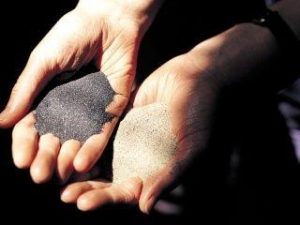
Rutile is mainly composed of titanium dioxide. Synthetic rutile is produced from the naturally occurring ilmenite. It is a complex oxide of iron. Synthetic rutile is used as a byproduct of titanium dioxide. The synthetic rutile can be made up of various colors by the doping method. Synthetic rutile which has a relatively high titanium dioxide content and also contains low levels of contaminants which affects the chlorination process, it is also used in the pigment industry. It can be produced with varying degrees of purity. The variation in the quantity and type of impurity present depends on the source of ilmenite as well as the method of extraction. Characteristically the synthetic rutile contains aluminum and ferrous impurities that are common alloying additions for a lot of commercial titanium alloys reducing the dependence on costly master alloys.
Related Projects:- Chemicals (Organic, Inorganic, Industrial) Projects
The synthetic rutile market varies as per the purity grade and application. Pigment companies have replaced natural rutile with the synthetic one. The production of synthetic rutile is regarded as more ethical and economical and is being increasingly adopted in the end-use industry.
Market Dynamics of Synthetic Rutile
Globally, the upswing in economies activity is projected to increase substantially in the following years. The growth of the manufacturing sector across the world is translating into an increase in the global growth momentum that is expected to have a considerable impact on different markets. The synthetic rutile is used in a lot of industrial applications as a pigment. With the increasing demand for synthetic rutile in the paper, food, plastic, and paint and coating industry, synthetic rutile is expected to deliver positive growth over the forecasted period.
Related Project: – SYNTHETIC RUTILE FROM ILMENITE
Industrialization in the developing countries is a noticeable reason behind the growth of synthetic rutile. With the increasing production of titanium, synthetic rutile production is also expected to increase. Natural rutile is not easily available. Hence, synthetic rutile is preferred. The high price associated with the extraction of natural rutile is also a significant factor for creating traction in the global synthetic rutile market. Stringent environment regulations are expected to hamper the synthetic rutile market growth. Manufacturers will have to lessen environmental impacts by reducing the toxicity levels during rutile production.
Related Books:- Chemical Technology (Organic, Inorganic, Industrial), Fine Chemicals
Regional Outlook on Synthetic Rutile Market
The Asia Pacific is expected to hold a major share in the synthetic market, as Australia and New Zealand are among the top producers of titanium metal. China is one of the top growing countries in the Asia Pacific region. China is accounted for high growth and a large share in the synthetic rutile market due to a high production of titanium metal and titanium oxide. With the growing industrialization in developing countries in the Asia Pacific region, high market growth is expected. North America followed by Europe, is anticipated to gain significant traction in the synthetic rutile market. As the demand in various end-use industries such as, paper, plastic, food, and others increases, the global consumption of synthetic rutile will also increase. Japan is also projected to have significant growth in the synthetic rutile market. Latin America and Middle East region are estimated to show sluggish growth in the synthetic rutile market.
Related Projects:- Chemicals, Biotechnology, Enzymes, Bio Fertilizer, Vermiculture, Vermicompost Chemical & Allied Industries and Alcohol Projects
Conclusion
“Synthetic Rutile from Ilmenite” is the project report by NPCS. The report includes other market data like key players in the Industry segment along with their contact information and recent developments. It includes crucial information like raw material requirements, list of machinery and manufacturing process for the plant. Core project financials like plant capacity, costs involved in setting up of project, working capital requirements, projected revenue and profit are further listed in the report.
Related Videos:- Chemicals (Organic, Inorganic, Industrial)
Noo_Art2021